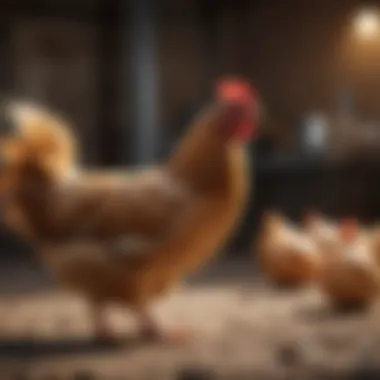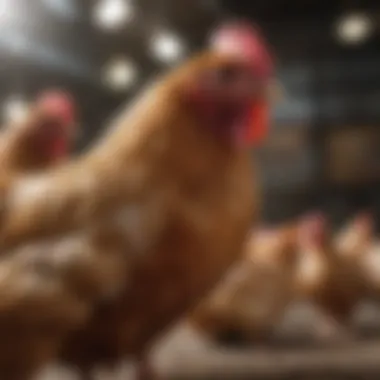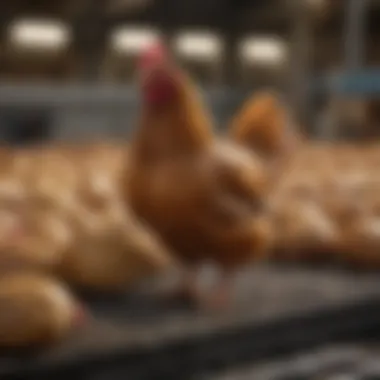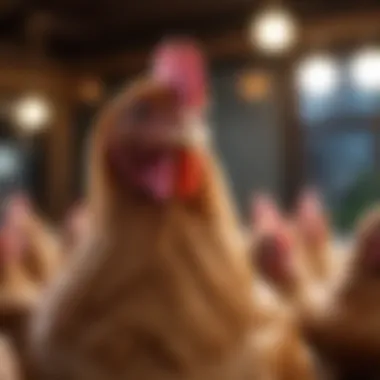Understanding Price Dynamics of Live Chickens in 2023


Intro
The poultry market, specifically the live chicken segment, is a complex and dynamic field. Understanding its price dynamics is essential for farmers, retailers, and consumers alike. Several factors contribute to the fluctuation of prices, including market trends, geographic variations, and consumer demand. This article aims to dissect these elements to provide a coherent overview of how prices are determined in this vital sector.
Market Trends
Market trends play a significant role in influencing the price of live chickens. Economic conditions, coupled with shifts in consumer preferences, dictate the fluctuation of chicken prices. The rise of organic and free-range poultry has reshaped consumer buying habits, demanding higher prices for perceived quality. Conversely, increased production of traditional farm chickens, facilitated by advancements in farming technology, can lead to price drops.
Geographic Variations
Pricing of live chickens varies markedly across regions. In urban centers, prices tend to be higher due to increased operational costs and higher demand. Rural areas, on the other hand, often witness lower prices, affected by local supply and demand constraints. Factors such as transportation expenses and local market regulations also contribute to these disparities.
“In many regions, the local economy can drastically affect chicken prices, with farmers often adjusting to distant market fluctuations.”
Supply Chain Logistics
Understanding the supply chain logistics offers a glimpse into the challenges faced by poultry producers. The journey from farm to market involves multiple steps: production, processing, transportation, and storage. Each stage adds additional costs that influence the final price of live chickens.
Production Costs
Production costs include feed, labor, and veterinary care. With feed prices being inherently volatile, any fluctuations can directly impact chicken pricing. Moreover, chicken farming practices, such as the use of antibiotics or organic methods, can incur different costs affecting overall pricing strategies in the market.
Transportation and Storage
Effective transportation and storage solutions are vital to maintaining the quality of live chickens. A delay in transport can result in losses that farmers may pass on to consumers through higher prices. Additionally, storage facilities must meet regulatory standards, further adding to the cost structure.
Consumer Demand
Consumer demand is perhaps the most unpredictable factor affecting chicken prices. Seasonal trends, changing dietary preferences, and health concerns consistently reshape demand levels. For instance, a surge in demand during holiday seasons can drive prices up, while periods of low demand may result in price reductions.
Health and Safety Concerns
Growing awareness of food safety has led consumers to favor suppliers who demonstrate high standards. This behavior affects pricing strategies, as businesses that comply with safer farming practices often command higher prices.
Economic Conditions
Economic conditions, both locally and globally, contribute directly to chicken price fluctuations. Inflation, currency value changes, and international trade policies can affect both supply and demand dynamics.
Finale
The price dynamics of live chickens result from a blend of various interconnected factors. Understanding these elements provides insight for agricultural stakeholders and consumers, enabling informed decision-making in the poultry market. As more data emerges and economic conditions evolve, staying aware of these pricing models proves indispensable for anyone engaged in or relying upon the poultry industry.
Market Overview of Live Chicken Prices
The market overview of live chickens provides essential insights into the economic landscape surrounding poultry farming and retail. Understanding this section is crucial for anyone interested in the dynamics of chicken pricing. The prices of live chickens can reflect a variety of factors, including market demand, regional availability, and broader economic influences. A thorough examination of the current market trends and historical data is necessary to make informed decisions, whether one is a farmer, retailer, or consumer.
Current Market Trends
In the current market, live chicken prices are influenced by several factors. The demand for chicken has shown resilience due to its position as a staple protein source. Seasonal events, holidays, and changing dietary preferences also play roles in price fluctuations. For instance, the festive seasons often see a spike in demand, which subsequently drives up prices.
Moreover, recent trends show an increasing consumer preference for organic and free-range options. These factors have implications for pricing strategies, requiring farmers and retailers to adapt quickly. Factors such as feed costs, transportation expenses, and biosecurity measures also impact prices significantly. Indeed, the interplay between these elements helps form the current pricing landscape.
Historical Price Data
To comprehend the present market conditions effectively, it is critical to analyze historical price data. The historical context offers valuable perspectives on how prices have changed over time. For instance, in recent years, data indicates sharp increases in prices during times of supply shortages or economic downturns.
Analyzing past trends illuminates patterns that can help forecast future pricing scenarios. Utilizing diverse data sources, such as government reports and industry analyses, can yield a comprehensive overview. It is also useful to consider regional variations, as pricing data can differ significantly across locations due to local factors like feed supply and demand dynamics.


Overall, a detailed understanding of these aspects offers beneficial insights for stakeholders and helps navigate the complexities of the live chicken market.
Factors Influencing Chicken Pricing
Supply and Demand Dynamics
The primary force shaping market prices is the relationship between supply and demand. When demand for live chickens increases, perhaps due to rising consumer interest in poultry-based diets, prices typically rise. Conversely, if supply exceeds demand, prices tend to fall. This fundamental economic principle applies not only to chickens but to most commodities.
In the chicken market, demand can be driven by various circumstances. A notable example includes seasonal consumption spikes during holidays or local events. During such times, consumers are more likely to purchase larger quantities of chicken for meals, leading to price hikes. On the other hand, during off-peak seasons, prices may drop as producers seek to sell excess stock.
The balance of these forces can be seen in many market analyses. Understanding these dynamics equips farmers and retailers with the knowledge to predict trends and adjust their strategies accordingly.
Seasonal Variations
Seasonal variations significantly affect live chicken pricing. Some seasons see increased purchases due to festivities, holidays, or cultural events. For instance, in many regions, demand peaks around Thanksgiving in the United States, where the turkey market dominates. However, chicken consumption also sees a rise as consumers often opt for a variety of meats.
Moreover, seasonal weather changes can play a pivotal role in the supply chain. For example, harsh winters may affect the transport of chickens, leading to supply shortages. Such disruptions can result in price spikes. Conversely, during the warmer months, increased production and harvesting can lead to an oversupply, consequently lowering prices.
It's vital for producers to understand these seasonal patterns. Recognizing when to ramp up supply or when to hold back can greatly influence profitability and market stability.
Regional Differences in Pricing
Regional differences in pricing reflect local market conditions, consumer preferences, and logistical challenges. Various regions have unique factors affecting chicken prices. Urban areas may experience higher prices due to increased cost of living and demand, whereas rural areas might offer lower prices influenced by proximity to production farms.
Moreover, local regulations can impact pricing. For instance, regions with stringent health and safety regulations for poultry handling may incur higher operational costs, which is likely to be passed on to the consumer. Meanwhile, regions with less regulation could see lower prices but might compromise on quality and safety standards.
Understanding these regional nuances helps stakeholders navigate through pricing structures more effectively, benefiting both producers and consumers.
By grasping the intricate factors influencing chicken prices, all parties involved can better negotiate, plan and adapt to shifts in the poultry market.
Economic Factors Affecting Prices
The interplay of economic factors plays a crucial role in shaping the market for live chickens. Understanding these factors helps to reveal the underlying forces that contribute to pricing fluctuations and their broader impacts on the poultry industry. Key elements include inflation, the costs associated with feed, and dynamics in the labor market. These components are not just numbers on a spreadsheet; they encapsulate the challenges and opportunities that farmers, retailers, and consumers face.
Inflation and Cost of Feed
Inflation significantly affects the price of live chickens, with food inflation being an especially critical subsector. Rising costs for feed, commonly made with corn and soybeans, translate directly to higher expenses for poultry farmers. As feed prices rise, the cost burden is often passed down the supply chain, resulting in higher prices at the retail level. It is essential to monitor current trends in agricultural commodities as they can predict live chicken pricing.
A few points to consider regarding inflation and feed costs include:
- Price Volatility: Fluctuations in feed costs due to weather events or geopolitical tensions can create unpredictable pricing landscapes.
- Price Pressure on Farmers: As feed prices increase, profit margins for farmers shrink, impacting their ability to maintain operations.
- Consumer Ripple Effects: As live chicken prices rise, consumers may shift preferences to alternatives, impacting overall market dynamics.
Understanding inflation's impact can aid consumers and farmers in navigating pricing uncertainties.
Labor Market Impact
The labor market profoundly influences the poultry industry, affecting everything from production costs to the availability of skilled labor. A robust labor market leads to higher wages and, consequently, increased operational costs for poultry producers. Farmers may struggle to retain workers if the labor market tightens, leading to inefficiencies and potentially affecting the quality of the product. Furthermore, automation trends can complicate labor dynamics, offering both challenges and solutions.
Key aspects to consider regarding labor market impacts include:
- Wage Changes: Rising wages lead to higher operational costs and may result in increased prices for consumers.
- Production Efficiency: A skilled workforce is vital for streamlined production processes, which directly affect the price per chicken.
- Automation Trends: The integration of technology can mitigate labor shortages but requires initial investment, impacting short-term pricing.
Each of these economic factors synergistically affects the pricing of live chickens, contributing to the overall stability and adaptability of the market. Monitoring these elements can provide insights into future pricing trends and consumer behavior expectations.
Consumer Behavior and Purchase Trends
Understanding consumer behavior and purchase trends is essential in evaluating the price dynamics of live chickens. This segment investigates how consumer choices shape the poultry market and subsequently, pricing strategies. Various factors, including shifts in preferences and the demand for specific types of chicken, play critical roles in influencing prices.
Shifts in Consumer Preferences


Recent years have shown notable shifts in consumer preferences regarding chicken products. Factors such as increased health awareness, concern for animal welfare, and the rise of ethical consumption have influenced buying decisions. For example, more consumers opt for meat from chickens that are raised humanely. This shift has direct implications on pricing.
As consumers prioritize healthier and ethically sourced chicken, they may favor organic or free-range options over conventional ones. This transition has led to an increase in demand for premium-priced products, causing a ripple effect in the market. Farmers and suppliers are responding by adjusting their production practices to meet these new demands, balancing both quality and price.
Furthermore, digital trends have amplified these changes. Online shopping and social media provide platforms for consumers to share preferences, influencing broader purchasing behaviors. This phenomenon means that the traditional price-setting models must adapt to accommodate consumer feedback more effectively.
Impact of Organic and Free-range Chicken
The demand for organic and free-range chicken is one of the most significant trends impacting pricing in today’s market. Consumers are increasingly aware of the conditions in which their food is produced. As a result, many prefer chicken that is raised without antibiotics or hormones, and in environments where they can roam freely.
The production of organic and free-range chickens typically incurs higher costs due to stricter regulations and larger space requirements per bird. These costs often translate into higher prices for consumers.
Poultry Farming Practices and Their Influence
Poultry farming practices significantly affect the price dynamics of live chickens. These practices influence not only the productivity and health of the birds but also the overall quality and marketability of the products. Understanding how these practices interplay with pricing helps stakeholders make informed decisions. Efficient farming methods can lead to cost savings and higher pricing power, which ultimately impacts the supply chain and consumers.
Breeding Practices
Breeding practices in poultry farming play a crucial role in shaping the genetic traits of chickens. These traits affect growth rates, feed efficiency, and overall health. Farmers must decide whether to use commercial breeds, which often have better yields, or heritage breeds that may appeal to niche markets. The breed selected can also influence production cycles and feed costs.
Key factors to consider in breeding practices include:
- Genetic Selection: Choosing the right breeds for specific environments and markets increases profitability.
- Crossbreeding: This method can enhance traits like growth rate and disease resistance.
- Breeding Programs: Structured programs help farmers manage the genetic diversity of their flocks, improving resilience.
Such practices directly impact pricing. Fast-growing birds lead to quicker market availability, which may lower prices due to increased supply. In contrast, if a farmer focuses on traditional breeds, prices may rise because of lower supply and higher demand from specific consumer segments. Hence, a deep understanding of breeding practices is essential for effective pricing strategies in poultry farming.
Health Management and Biosecurity
Health management and biosecurity are paramount in poultry farming. A robust health management plan ensures that chickens are raised in optimal conditions, reducing disease prevalence. Higher health standards typically lead to better growth rates and overall quality, which can positively affect pricing.
Essential elements of health management and biosecurity include:
- Vaccination Programs: Regular vaccinations protect chickens from common diseases, reducing mortality rates and associated costs.
- Sanitation Practices: Keeping the facilities clean minimizes the risk of disease outbreaks.
- Monitoring and Diagnostics: Regular health checks allow for early detection of illnesses, meaning quicker interventions.
Effective health management not only ensures a high-quality product but can also lead to lower feed costs. Healthier birds grow faster and convert feed more efficiently.
Failure to implement these practices can have dire consequences. Outbreaks of diseases such as avian influenza can lead to a significant drop in chicken availability, driving prices up. Conversely, well-managed operations can position themselves favorably within the market, potentially allowing for higher pricing strategies. Thus, health management and biosecurity are crucial for sustaining and enhancing profit margins in the live chicken industry.
Regulatory Environment and Its Impact
The regulatory environment plays a crucial role in shaping the pricing dynamics of live chickens. It encompasses a range of policies and rules implemented by governments that govern the poultry industry. Understanding these regulations is essential for both consumers and producers. They influence production practices, trade, and ultimately the costs incurred along the supply chain.
Government policies serve as a framework within which poultry farms operate. Compliance with these policies can lead to better pricing stability and access to markets. On the other hand, failure to adhere to regulations can result in fines or increased operational costs, which can affect pricing.
Moreover, regulatory measures can promote animal welfare, food safety, and environmental sustainability, essential concerns for today’s consumers. These elements can shift demand and affect prices significantly.
Government Policies on Poultry
Government policies on poultry are designed to regulate the industry for several key reasons. First, they help ensure animal welfare by mandating proper housing, feeding, and medical care for chickens. This contributes not only to the ethical treatment of animals but also to the quality of the meat produced.
Second, such policies play a role in food safety. Governments often establish guidelines to prevent diseases that can arise in poultry populations, which can have dire consequences for public health. The implementation of vaccination programs and biosecurity measures is essential.
Finally, policies related to subsidies can impact pricing. Farmers benefiting from government support can offer competitive prices, making live chickens more accessible to consumers.
- Animal Welfare Initiatives: Policies enforce standards for housing and treatment.
- Food Safety Regulations: Guidelines are in place to avoid public health crises.
- Subsidies and Grants: Financial assistance can enhance market competitiveness.
Trade Regulations and Tariffs
Trade regulations and tariffs also significantly influence the live chicken market. Tariffs can raise prices for imported chickens, making domestically produced poultry more appealing to consumers. However, if domestic producers cannot compete with international prices due to high tariffs, it might limit choices for consumers and increase overall market prices.


Moreover, trade agreements can affect supply chains. Favorable agreements can open new markets for producers, leading to increased competition and potentially lower prices. Conversely, restrictions can limit access to essential export markets, impacting supply and prices negatively.
In sum, understanding the regulatory landscape surrounding the poultry industry offers insights into its pricing framework. It highlights the importance of compliance and the effects of trade dynamics on market stability, making it a vital area of focus for anyone interested in the economic aspects of live chickens.
“Government policies and trade regulations create the backbone on which the live chicken pricing rests. Analyzing these elements is essential for a complete understanding.”
Technological Advances in Poultry Production
Automation in Poultry Farming
Automation plays a critical role in modern poultry farming. The deployment of automated systems can streamline various processes, such as feeding, watering, and monitoring. This leads to reduced labor costs and increased productivity. Farmers now use computerized feeding systems that provide precise amounts of feed at optimal times. This not only saves expenses but also aids in maintaining poultry health.
For example, automated environmental control systems ensure optimal conditions for chicken growth. These systems can adjust temperature, humidity, and ventilation, contributing to healthier birds and better meat quality. Enhanced conditions naturally lead to higher market prices for the end products, thereby influencing the pricing models in the chicken market.
In addition, technology facilitates biosecurity measures. Automated surveillance helps in tracking the health of flocks and detecting outbreaks of diseases earlier. The result is usually a reduction in losses due to illness, which positively affects the supply and pricing of live chickens.
Data Management and Analytics
Data management and analytics are key components in advancing poultry production. The use of data enables farmers to make informed decisions based on real-time information. Farmers are increasingly adopting precision agriculture techniques that leverage data analytics for improved chicken farming practices.
By analyzing data related to feed consumption, weight gain, and health indicators, producers can optimize resource allocation and reduce waste. Predictive analytics can help farmers forecast outcomes based on historical data, allowing for strategic planning of production levels. This strategic approach to farming can lead to stabilized prices by meeting market demand more accurately.
Moreover, utilizing data also fosters better supply chain logistics. With real-time tracking, producers can ensure that their products reach markets efficiently. Supply chain effectiveness plays a vital role in maintaining competitive prices in the live chicken market.
Effective use of data management can lead to reduced costs and better product availability, ultimately influencing price stability in the market.
Future Predictions for Live Chicken Pricing
Understanding future predictions in live chicken pricing is crucial. The poultry market is influenced by a range of factors that can lead to significant price variations. Looking ahead offers insights into sustainability and economic viability for farmers and consumers alike.
Market Sustainability
Market sustainability involves the balance between production and consumption of live chickens. Strategies for sustainable farming practices can mitigate environmental impact while ensuring consistent chicken supply. This balance affects price stability. Factors such as land use, water resources, and feed effectiveness all contribute to sustainability.
- Sustainable Practices: Utilizing organic farming, water conservation, and renewable energy sources can positively affect costs.
- Consumer Preferences: Growing demand for sustainably raised chickens drives farmers to adapt their methods.
- Regulation and Compliance: Meeting sustainability regulations can initially elevate costs but ultimately lead to long-term gains.
Adoption of these sustainable practices may reduce overall costs, leading to more stable prices in the market.
Potential for Price Fluctuations
Price fluctuation is a reality in the live chicken market. Understanding potential reasons for these fluctuations helps stakeholders prepare and respond effectively. The following factors contribute to this volatility:
- Supply Chain Disruptions: Issues such as transportation delays can lead to immediate price increases.
- Economic Factors: Inflation and changes in feed costs directly affect pricing.
- Consumer Demand Shifts: Changes in diet trends or economic conditions can lead to sudden fluctuations.
“Anticipating fluctuations can allow farmers to strategize their production and pricing models.”
In summary, predicting the future pricing dynamics of live chickens requires attention to sustainability and potential market fluctuations. As we move forward, these areas will play a vital role in shaping the live chicken market.
Finale
The conclusion section of this article synthesizes the main themes of the pricing dynamics associated with live chickens. Understanding these price dynamics is crucial for various stakeholders including farmers, consumers, and pet owners. The insights gained from the analysis help in making informed decisions regarding purchasing and selling live chickens, ensuring sustainability in the poultry market.
Summary of Key Points
This article has explored several critical aspects affecting the price of live chickens:
- Current Market Trends: The shifts in demand and pricing structures due to various external factors.
- Economic Factors: The influence of inflation and changes in labor costs on overall chicken prices.
- Consumer Behavior: Trends in buyer preferences, particularly the increased demand for organic and free-range options.
- Poultry Farming Practices: The role of breeding and health management in shaping supply.
- Technological Advances: How automation and data analytics are transforming production processes.
- Regulatory Impact: Government policies and trade regulations that directly affect pricing.
Understanding these elements enables stakeholders to navigate the complexities of the market environment, adjusting strategies as needed.
Implications for Pet Owners and Farmers
For pet owners, comprehending the price dynamics of live chickens is essential. It helps them evaluate the long-term costs associated with poultry ownership, including feed prices and veterinary expenses. As demand for certain types of chickens fluctuates, prices can vary significantly, influencing purchasing decisions.
Farmers must stay informed about market trends and consumer preferences to remain competitive. They should adopt best practices in poultry management and be aware of the implications of regulatory changes on their operations. Keeping abreast of economic indicators can also provide farmers with insights into when to buy feed or when to sell their chickens for optimal profit.















